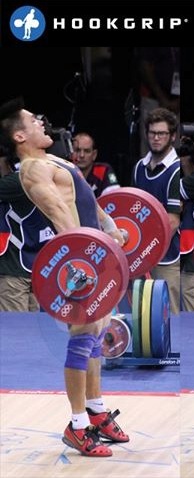5 Ways To Keep The Second Pull Straight in Weightlifting.
Here's a prelude to the next Training Geek Weightlifting Biomechanics Workshop: Keeping Your Second Pull Straight (what a mouthful!). I also previously mentioned why it is important to keep the second pull straight.
 Image from Hookgrip.
Image from Hookgrip.
Now, here are 5 things to think about which may help you get slightly more vertical displacement of the barbell:
1. Extend the Second Pull.
Getting the bar to the hips is the start of the second pull. Extending the hips is the next part. But that's not the end. Finishing the second pull before the immediate reversal to drop under the bar is critical. That small little bit makes a whole lot of difference.
2. Keep the Bar Close.
In relation to the first point, even if you are able to extend the second pull, you still need to ensure that it continues moving up. Most of the time, many forget about this, extend the hell out of the hips and leave the bar out there while finishing the pull, resulting in pushing the bar forward into a larger loop.
3. Lean Back SLIGHTLY.
This is one that I am personally still working on. It has been mentioned before that by leaning the torso back slightly, you are creating an allowance for the barbell to move vertically when the second pull is finally executed. By keeping your torso too vertical, unless you have very excellent shoulder internal rotation, you will always have the bar moving forward after the second pull is executed. Lean too far back (which I tend to do sometimes) and you will have to jump back to compensate for that.
4. Make Your Legs Strong.
Having strong legs doesn't mean having a big squat or being able to do heavy pulls. It's about striking a balance between anterior leg strength (quads) and posterior chain strength (glutes and hamstrings). By striking that balance it helps to ensure that when the second pull is executed, the legs help drive force into the ground evenly hence keeping it moving relatively vertical.
5. Think of The Bar.
I understand that what I have mentioned are a few things that you can try to do to get the bar moving straight. But the more important thing to remember is that movement patterns are built upon individual physical characteristics. Being able to use what works best for you to keep the bar moving straight is more important. How you want to do it is something you need to internalise and make it work for you for the result you want.
Just some of the things I will be talking about in another 10 days or less. Are you joining us in that conversation?

